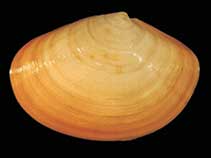Aequiyoldia eightsii (Jay, 1839)
Antarctic yoldia
Classification / Names Common names | Synonyms | CoL | ITIS | WoRMS
Bivalvia | Nuculanida | Sareptidae
Environment: milieu / climate zone / depth range / distribution range Ecology
Benthic; depth range 36 - 380 m (Ref. 7659). Subtropical; 24°S - 77°S, 175°W - 175°E
Distribution Countries | FAO areas | Ecosystems | Occurrences | Introductions
Eastern Pacific, Southwest Atlantic and the Antarctic. Subtropical to polar.
Length at first maturity / Size / Weight / Age
Maturity: Lm ? range ? - ? cm Max length : 3.0 cm SHL male/unsexed; (Ref. 7659)
Also in Ref. 83435 (Ref. 2590).
Life cycle and mating behavior Maturity | Reproduction | Spawning | Eggs | Fecundity | Larvae
Members of the class Bivalvia are mostly gonochoric, some are protandric hermaphrodites. Life cycle: Embryos develop into free-swimming trocophore larvae, succeeded by the bivalve veliger, resembling a miniature clam.
Main reference
References | Coordinator | Collaborators
SAUP Database. 2006. (Ref. 356)
IUCN Red List Status (Ref. 130435)
CITES status (Ref. 108899)
Not Evaluated
CMS (Ref. 116361)
Not Evaluated
Threat to humans
Harmless
Human uses
| FishSource |
Tools
More information
Internet sources
BHL | BOLD Systems | CISTI | DiscoverLife | FAO(Publication : search) | Fishipedia | GenBank (genome, nucleotide) | GloBI | Gomexsi | Google Books | Google Scholar | Google | PubMed | Tree of Life | Wikipedia (Go, Search) | Zoological Record
Estimates based on models
Preferred temperature
(Ref. 115969): 1.3 - 9.3, mean 6 (based on 298 cells).
Resilience
(Ref. 69278):
Low, minimum population doubling time 4.5 - 14 years (K=0.06).
Price category
(Ref. 80766):
Unknown.



